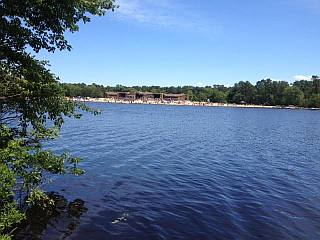* Home
|
-- New Jersey Day Trips -
-- Liberty Park -- Princeton -- Lambertville -- Morristown -- Pinelands -- Camden -- Wildwoods -- Cape May -- Asbury Park -- Ocean Grove -- Trenton The Pinelands (or Pine Barrens), which was placed under strict regulatory controls over development pursuant to state and federal legislation enacted in the 1970s, comprises over a million acres--a fifth of New Jersey's land area. It is the largest body of open space on the Mid-Atlantic seaboard between Richmond and Boston, and its Kirkwood-Cohansey aquifer system contains an estimated 17 trillion gallons of water, representing nearly half the water consumed each year in the nation. Seven state parks are located in the Pinelands, offering a diverse mix of trails, rivers and streams, along with blueberry fields and cranberry bogs. Given its vast expanse and diverse resources, a day trip to the Pinelands might target a visit of a couple hours to one of the state parks with a surviving village (such as Wharton State Forest with its Batsto Village or Brendan T. Byrne State Forest with its Whitesbog Village), perhaps complemented by a hike along one of the many easy forest trails or canoe or kayak trip on a river or lake. The region is home to dozens of rare plant and animal species. Its forests and wetlands host over 40 threatened or endangered animal species, including the Pine Barrens Tree Frog (Hyla andersonii), a species found in very few places other than the Pinelands. Town and villages in the Pinelands, some of which were founded as religious communities, include several sites on the National Register of Historic Places. The Pinelands were originally inhabited by Lenni Lenape Native Americans, many of whom left the region or sold their lands as European settlers arrived, with their numbers also depleted by disease from their contacts with the Europeans. In 1758, the first Indian reservation in the country, the Brotherton Reservation at what was called Indian Mills (present Shamong Township), was established on 3,200 acres within the Pinelands for the remaining Lenni Lenapes in the colony. English, Irish, and Scottish settlers came to the forests in the 18th century, later joined by the Dutch, Germans, and a few free blacks. In later years, new communities made up of displaced groups including Russians and Jews were formed. During World War II, interned Japanese-Americans were relocated by the federal government from the West Coast to the region to work at farms and other facilities at such businesses as Seabrook Farms in Bridgeton. Initially, the forests were harvested for lumber and shipbuilding, with the streams sources for bog iron (including cannon balls and other ammunition for Continental soldiers in the Revolutionary War). As the bog iron industry declined with competition from coal-fired plants in Pennsylvania, the installations were converted to glass factories, paper mills, cotton mills, sawmills, and brick and tile factories. "Company towns" with worker housing and stores were built near the furnaces and forges, but these industries, often impacted by forest fires, were unable to support a stable long-term economy. Agriculture continues to survive as a source for seasonal jobs for farmworkers, led by blueberry, cranberry and soybean cultivation. During the Great Depression of the 1930s, the Pinelands became one of the sites of the economic recovery programs of the New Deal as the Civilian Conservation Corps established camps to house workers on various projects such as creating artificial lakes and building forest fire watch towers. As New Jersey rapidly developed following the end of World War II, the expanse of Pinelands forests increasingly became targeted for major development, including large housing and retirement communities on its eastern and western fringes. Perhaps the most controversial concept, however, was locating a giant airport to serve as an air hub midway between New York City and Philadelphia, a facility expected also to generate surrounding commercial, industrial and housing development. When Governor Brendan Byrne took office in January 1974, he aggressively opposed further development, blocking construction of the proposed Driscoll Expressway which would have extended the New Jersey Turnpike from Middlesex County through the Pinelands to Toms River and, in his second term, successfully pushing for state and federal legislation to establish a long-term program for the region's preservation under a plan and regulations adopted by the New Jersey Pinelands Commission. * Pinelands Protection Act of 1979 * National Parks and Recreation Act of 1978 * History of the Pinelands * Pinelands Commission * Pinelands Preservation Alliance * Pinelands Canoe Liveries * PineyPower.com * Pinelands Cultural Society & Albert Music Hall * Chatsworth Cranberry Festival * Pine Barrens Jamboree  Exhibit displaying bog iron in Batsto Village in Wharton State Forest. Image: NewJerseyAlmanac.com Exhibit displaying bog iron in Batsto Village in Wharton State Forest. Image: NewJerseyAlmanac.com
.
* 16 Unique Places to Eat and Drink in the New Jersey Pine Barrens, 12/1/2018, JerseyBites.com
* 13 Things You Might Not Know About the Pine Barrens, 2/12/2016, PhillyMag.com * Best Hikes in South Jersey, NJHiking.com * Pinelands Trips & Outings, PinelandsAdventures.org - Day Trips - -- Liberty Park -- Princeton -- Lambertville -- Morristown -- Pinelands -- Camden -- Wildwoods -- Cape May -- Asbury Park -- Ocean Grove -- Trenton |
|




